Münzgasse (Tübingen)
The Münzgasse is one of the oldest streets in the old town of Tuebingen . It is named after the former mint in No. 6, a mint from the Palatinate . Until the middle of the 19th century, the university had its central facilities here (auditorium, collegiate church, college building), as well as stately townhouses of the nobility and the houses of professorial families.
location
The 180 m long Münzgasse first ascends and then descends to the east between the Faulen Eck in the west and the collegiate church and from there to the north to the Holzmarkt in the east in the Tübingen upper town.
history
An archaeologically documented Alemannic - Merovingian grave field with finds from the 1st half of the 7th century west of the later-built collegiate church in Münzgasse 32 is one of the earliest signs of settlement in the later urban area.
The two- to four-storey plastered half-timbered buildings, most of which are now under monumental protection, are essentially medieval, and were erected in the west predominantly gable and in the east mostly eaves along Münzgasse. Because of the sloping slope towards the Neckar, the buildings in the south have high sloping floors with cellars and entrances.
There are still some historic university buildings as well as university-related buildings such as professors' houses, student dormitories, book printers and publishing houses. In addition to the upscale town house buildings and two patrician courtyards, the founding buildings of the university and the collegiate church, whose choir was used by the university until the construction of the (now old) auditorium in Münzgasse 30, are located in the east .
The late medieval residential and university buildings along Münzgasse shape the western Neckar front to a large extent and are of great testimony both to the history of the city and the history of the University of Tübingen.
building
| image | No. | description |
|---|---|---|
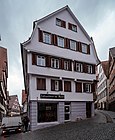
|
1 | Three-storey town house on the Faulen Eck, facing the Münzgasse; plastered half-timbered tower above massive ground floor and barrel vaulted cellar; Mansard gable roof. The house is first attested in 1525 and was inhabited by university members in the 16th and 17th centuries. "Waldhorn" inn in the middle of the 18th century. Cultural monument. |

|
2/4 | Four-story residential house facing Münzgasse and six-story gable-independent house towards Klosterberg with a plastered half-timbered tower above the massive ground floor and vaulted cellar. Gable roof set off like a mansard. Houses No. 2 (built around 1500) and No. 4 (first mentioned in a document in 1498) were merged in the middle of the 18th century and were given a common gable. Cultural monument. |

|
3 | Three-storey residential house on the eaves with a steep pitched roof on a trapezoidal floor plan. Narrow gable towards Münzgasse. Barrel-vaulted cellar, massive ground floor, plastered half-timbered structure. 1653 residence of the theologian Balthasar Raith . Cultural monument. |
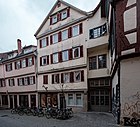
|
5 | Four-storey, gable-independent half-timbered building, essentially plastered from the late Middle Ages. Today: Schmuckstüble Gotlinde Waidelich. |
 |
6th |
In the 14th and 15th centuries the mint of the Counts of Tübingen and Count Eberhard im Bart was located here . Due to the noise, it was moved to the outskirts of the city in Neckarhalde 30. The current building at Münzstr. 6, together with Clinicumsgasse 3, is the possible successor to the Alte Münze: cellar probably still in the 15th century, ground floor in the 16th century, facade redesigned in the 18th century. Cultural monument. |

|
7th | Nursing yard of the Blaubeuren monastery from 1412 to 1505 with preserved large cellars. Converted into a patrician court in 1505; The half-timbered facade comes from this construction project. Later the seat of the nobility (coat of arms of the von Ertingen family and the year 1740). The Gasthof zum René was founded in 1848 by beer host Andreas Denneler. Since 1913 the building was known as a Catholic clubhouse , as several Catholic clubs had their headquarters here. The inn was closed in 1938. Cultural monument. Today student residence. |

|
8th | The only house on Münzstrasse that was not inhabited by academics, but by changing craftsmen, in 1763 by an antiquarian and in 1804 by a bookbinder.
Small vaulted cellar, massive ground floor (four windows with folding shutters), overlaid half-timbered building, old loading hatch in the gable. in the core 15th century, today's appearance 18th century. Cultural monument. |

|
9 | Headquarters of the Osiander bookstore . Elongated three-storey building with a gable roof. Large, still medieval vaulted cellar, after a fire in 1780 by the bookseller Jakob Friedrich Heerbrandt: high, massive ground floor with two house entrances (segmental arches), side gate, mezzanine, above it a plastered half-timbered tower. Parts of the historical interior: staircase, stucco, wall paneling. Cultural monument. |

|
10 | Aristocratic seat in the 15th century, later owned by the Gmelin family. In 1907 in his will to the Vincentine Sisters of the Untermarchtal Monastery for charitable purposes. The house, built in 1522, now belongs to the Catholic Church Community of Tübingen. It was fundamentally renovated in 1994, taking into account the monument preservation requirements for the preservation of a high-ranking architectural monument, and converted into a contemporary residential and office building for changed uses. Serious structural and physical deficiencies were eliminated and the floor plans were modernized, including for the pastor's apartment in the St. John's inner city church. The entire attic was rebuilt due to the poor condition of the existing building. Cultural monument. |

|
11 | On an elongated floor plan, a gable-independent and an eaves-standing building. Core building of the gable-facing house after the university was founded in 1477, building on the eaves after fire in 1624. The official seat of the university chancellor, who was originally also a provost and theology professor. Cultural monument. Institute for educational science (adult education, further education) of the economics and social science faculty of the University of Tübingen. Other rooms of this institute are in Münzgasse 22–30. |

|
12 | The house has been inhabited by professors since the university was founded. Large high mediaeval cellar, above it a massive ground floor with a profiled arched portal, plastered half-timbered top (late 16th century) and gable roof. Cultural monument. |
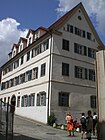
|
13 | Martinianum |

|
14/16 | Erected around 1500, former aristocratic seat (coat of arms on the portal: Konrad von Fürst and Anna von Neuneck, 1548) with a beautiful inner courtyard. |

|
15th | Cottahaus: A bookseller dynasty lived here since Johann Georg Cotta settled in Tübingen in 1659 and until he moved to Stuttgart (1810). |
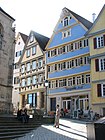
|
17th | Today it is the Tangente Jour , a French-style café-bar with a street café, a bistro and a cocktail lounge. |

|
18th | So-called "Klösterle". According to the building inscription, it was built in 1490 by Ludwig Truchseß von Höfingen , a professor of canon law. In the 19th century, a foundation for impoverished single women and widows of the class who had free board and lodging here. |

|
20th | Built in 1489 as a lecture hall for the Law Faculty, since 1653 for the Philosophical Faculty. In municipal ownership since 1847 (girls' elementary school, later elementary school). In the basement is the oldest German university prison, which has been used since 1515. Since the delinquents left graffiti on the walls, the university administration arranged for the two barrel-vaulted rooms to be painted with biblical scenes in 1736. |

|
22/28 | Old college building of the university, built in 1484. |
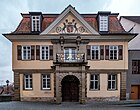
|
30th | Old assembly hall |

|
32 | Collegiate church |
literature
- Wilfried Setzler : Tübingen. Discover new things on old ways. A city guide. Schwäbisches Tagblatt publishing house. 4th edition, Tübingen 2005, ISBN 3-928011-54-5 , pp. 44-51.
Individual evidence
- ↑ a b c d e f g h i j k l m n o p Alexandra Baier: Monument conservation value plan for the entire Tübingen complex. Retrieved January 6, 2019 .
- ^ Tübingen - old community ~ suburb - history.
- ↑ ... and say hello to the world! Tübingen - a university town on old postcards. Edited by Udo Rauch and Antje Zacharias, Tübingen, Stadtmuseum 2007, ISBN 978-3-910090-78-1 , p. 181 (Stadtarchiv Tübingen, Hartmaier collection, album 93).
- ↑ Helmut Krisch, Hans Dattler and Hans-Peter Stoiber: residential and office building in the Old Town Tübingen
- ^ Faculty of Economics and Social Sciences> Institute for Educational Science: Adult Education, Further Education. Retrieved January 5, 2019.
- ^ Tangente Jour on TÜpedia.
Coordinates: 48 ° 31 '11.3 " N , 9 ° 3' 17.2" E


